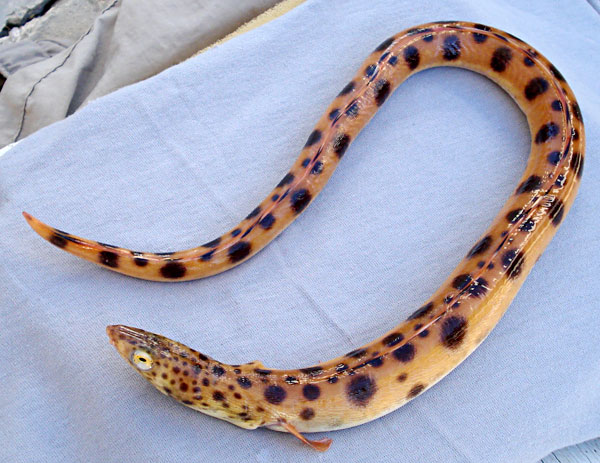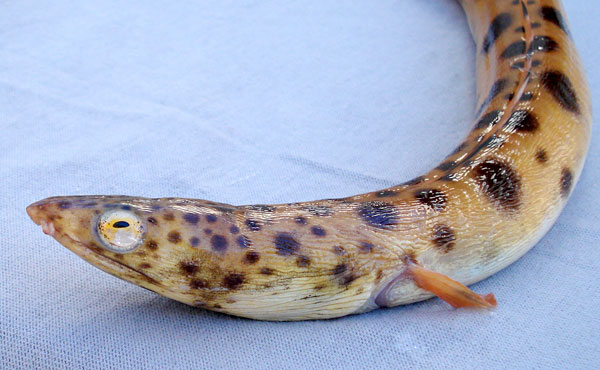Pacific Snake Eel
Tieso de Pacifico, Tieso Moteado
(Ophicthus triserialis)
Fish Identification Photos: Pacific Snake Eel, Ophicthus triserialis: The Pacific Snake Eel has a tan coloration with two rows of alternating red-brown spots on the body, the first of which is along the base of the dorsal fin and the second along the lateral line.
The Pacific Snake Eel has a cylindrical body with large eyes over the middle of the mouth. The dorsal fin originates over the rear of the pectoral fins and is yellow; the underside is spotless and pale. The tail of the Pacific Snake Eel is 53-58% of its total length and the tail has a pointed tip with no fins.
The Pacific Snake Eel is found in the first 500 feet of all Mexican waters except it appears to be absent from around the oceanic islands. The Pacific Snake Eel reaches 3.5 feet in length and is found in burrows in sandy and muddy bottoms. The Pacific Snake Eel can be confused with the Mustached Snake Eel, Herpetoichths fossatus (large brown spots), the Tiger Reef Eel, Scuticaria tigriria (small eyes and large brown spots) and the Tiger Snake Eel, Myrichthys tigrinus (large black spots).
The Pacific Snake Eel is one of several snake eels found in Mexican waters and is a member of the Opichthidae Family which includes Finless Eels, Ridgefin Eels, Snake Eels, Sailfin Eels, Sand Eels, Spoon-Nose Eels, Viper Eels and Worm Eels. They all have rounded cylindrical scaleless bodies with pointed snouts and small eyes found just above the mouth. Globally the family includes approximately 250 species.
The Ophicthus Genus includes the Snake Eels that are characterized by having tails with a sharp finless point, well developed pectoral fins opposite and above the gill openings, dorsal fins that originate above or behind the gill covers, tails that are longer than the heads and trunks, cylindrical bodies that are stouter than the tails, and large eyes over the middle of the mouth. Globally there are 60 members of this genus of which 5 are found in Mexican waters.


Tieso de Pacifico, Tieso Moteado
(Ophicthus triserialis)
Fish Identification Photos: Pacific Snake Eel, Ophicthus triserialis: The Pacific Snake Eel has a tan coloration with two rows of alternating red-brown spots on the body, the first of which is along the base of the dorsal fin and the second along the lateral line.
The Pacific Snake Eel has a cylindrical body with large eyes over the middle of the mouth. The dorsal fin originates over the rear of the pectoral fins and is yellow; the underside is spotless and pale. The tail of the Pacific Snake Eel is 53-58% of its total length and the tail has a pointed tip with no fins.
The Pacific Snake Eel is found in the first 500 feet of all Mexican waters except it appears to be absent from around the oceanic islands. The Pacific Snake Eel reaches 3.5 feet in length and is found in burrows in sandy and muddy bottoms. The Pacific Snake Eel can be confused with the Mustached Snake Eel, Herpetoichths fossatus (large brown spots), the Tiger Reef Eel, Scuticaria tigriria (small eyes and large brown spots) and the Tiger Snake Eel, Myrichthys tigrinus (large black spots).
The Pacific Snake Eel is one of several snake eels found in Mexican waters and is a member of the Opichthidae Family which includes Finless Eels, Ridgefin Eels, Snake Eels, Sailfin Eels, Sand Eels, Spoon-Nose Eels, Viper Eels and Worm Eels. They all have rounded cylindrical scaleless bodies with pointed snouts and small eyes found just above the mouth. Globally the family includes approximately 250 species.
The Ophicthus Genus includes the Snake Eels that are characterized by having tails with a sharp finless point, well developed pectoral fins opposite and above the gill openings, dorsal fins that originate above or behind the gill covers, tails that are longer than the heads and trunks, cylindrical bodies that are stouter than the tails, and large eyes over the middle of the mouth. Globally there are 60 members of this genus of which 5 are found in Mexican waters.
























